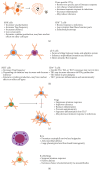Lymphocytes in Placental Tissues: Immune Regulation and Translational Possibilities for Immunotherapy
- PMID: 29348758
- PMCID: PMC5733952
- DOI: 10.1155/2017/5738371
Lymphocytes in Placental Tissues: Immune Regulation and Translational Possibilities for Immunotherapy
Abstract
Immune modulation at the fetomaternal interface is crucial to ensure that the fetal allograft is not rejected. In the present review, the focus is to describe basic functions of lymphocyte populations and how they may contribute to fetomaternal immune regulation, as well as determining what proportions and effector functions of these cells are reported to be present in placental tissues in humans. Also explored is the possibility that unique cell populations at the fetomaternal interface may be targets for adoptive cell therapy. Increasing the understanding of immune modulation during pregnancy can give valuable insight into other established fields such as allogeneic hematopoietic stem cell transplantation and solid organ transplantation. In these settings, lymphocytes are key components that contribute to inflammation and rejection of either patient or donor tissues following transplantation. In contrast, an allogeneic fetus eludes rejection by the maternal immune system.
Figures
References
-
- Benichou G., Valujskikh A., Heeger P. S. Contributions of direct and indirect T cell alloreactivity during allograft rejection in mice. The Journal of Immunology. 1999;162(1):352–358. - PubMed
Publication types
LinkOut - more resources
Full Text Sources
Other Literature Sources


